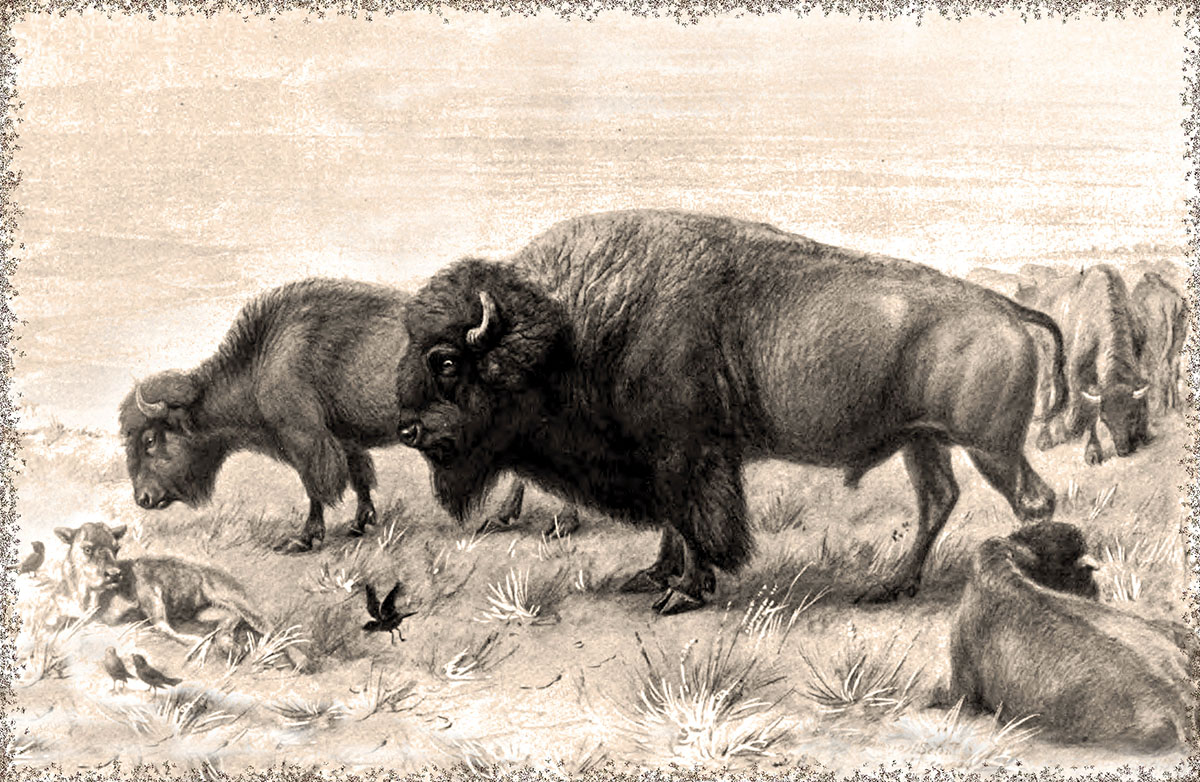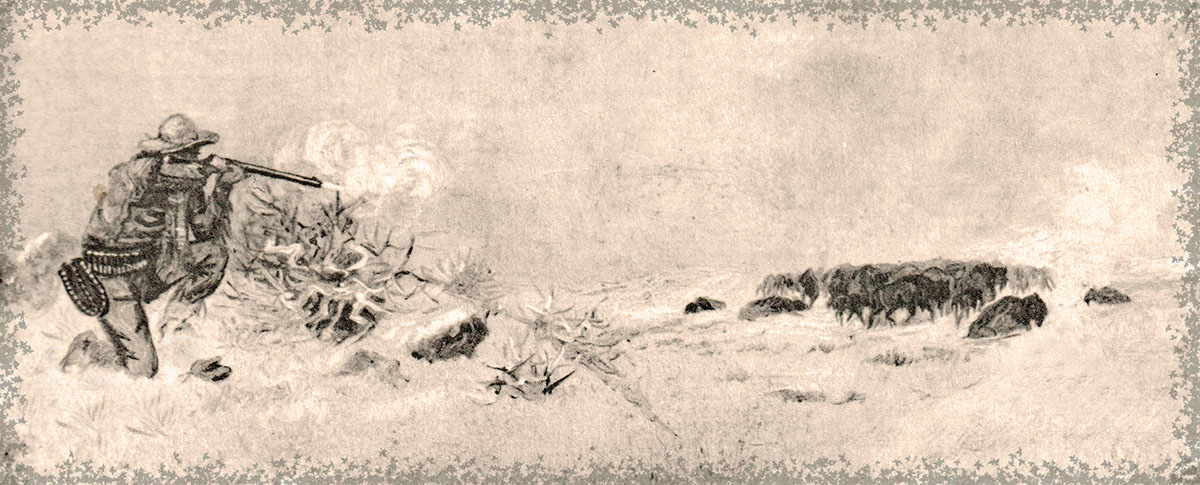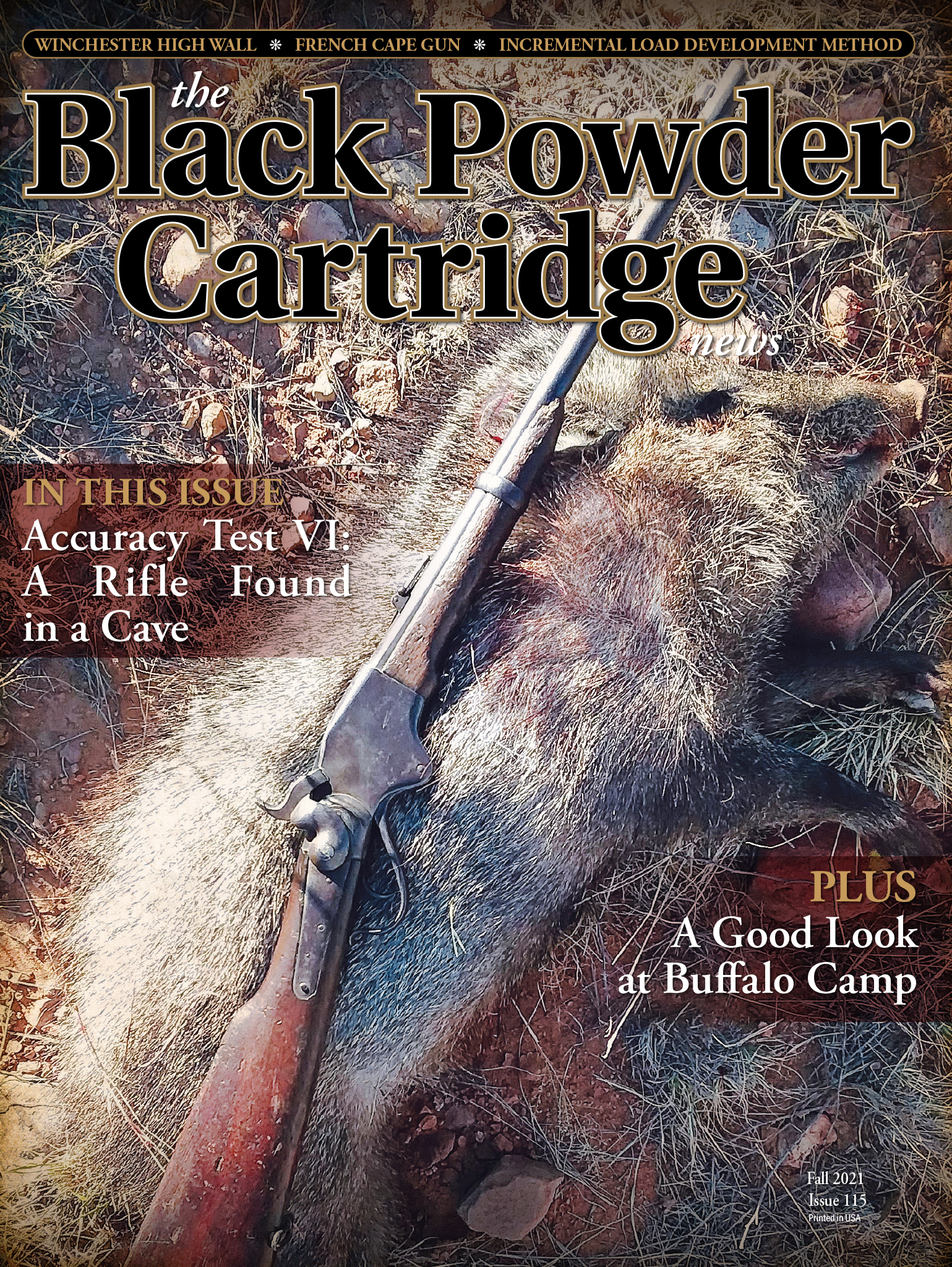Newspaper Articles
feature By: Leo J. Remiger | August, 21

For those who don’t know – a “buffalo-runner” is a man who hunts from horseback. It doesn’t make any difference if he is sport-hunting, meat-hunting or for that matter hunting for hides or robes. Nor does it make any difference if he is an Indian, a Metis, a Cibolero, a Comanchero, a sport-hunter, a military man or a cowboy – a buffalo-runner hunts buffalo from horseback.
Yes, I imagine it was quite exciting, but it was also extremely dangerous for the horse, not to mention the rider. There are a multitude of accounts that describe horses and riders being injured or even killed while “running” buffalo. It didn’t seem to make any difference if the riders were using a bow and arrow, a lance, a muzzleloader, breechloaders or revolvers. If they were running buffalo, somebody or something, besides the buffalo, were bound to be injured.
In some cases, the runners could get a buffalo herd milling by surrounding them. They sometimes killed all the buffalo in that herd from horseback and in a concentrated area. I’m sure that is a technique successfully used by Indians, Metis and Ciboleros. It would take a lot more individuals and horses than a typical Anglo hide-hunting outfit had available.
The professional buffalo hunter that made his living hunting buffalo for meat or for hides could not afford to have the carcasses strewn around the countryside. He could not afford to have his animals injured or be injured himself by running buffalo on horseback. That is why he was called a “still-hunter,” a “hide-hunter,” and in some cases, especially by eastern folks who had never seen a buffalo, experienced the dangers associated with living on the plains, or made a living by the rifle – a “game hog.”
He was not in the business for sport or excitement; he was in business to kill as many animals as his outfit could handle. He wanted his animals in a concentrated area to make it easier for his outfit to butcher the animals, either for meat or to peel their hides for market.
In reality, he was no different than the men who raised cattle, swine, sheep, turkey, or chickens for slaughter or the men that worked in the actual slaughterhouse, packinghouse or tannery peeling hides from carcasses. He just operated in a much more hazardous, some may even say dangerous environment, than they did.
Another question that baffles me is: “Why was all that meat left to rot on the plains?” That is a question that shouldn’t take too much mental exercise for anyone to answer. Professional hunters sold all the meat that the market demand called for. Just a minimal amount of research will illustrate that the majority of professional hunters sold meat to established brokers and agents for distribution to markets. I’m not talking about a ham here and a tongue there. I’m talking about millions of pounds of buffalo meat being shipped East to established markets. The Atchison, Topeka and Santa Fe railroad reached Dodge on September 23, 1872. By January 1873, some 43,029 buffalo hides and 1,436,290 pounds of buffalo meat were shipped East over that railroad.2
The Denver Rocky Mountain News of December 3, 1874, reported:
“But of still greater importance than bone-picking or hide-hunting, is the trade in buffalo meat. It has employed during the last year or two an amount of labor and capital that would seem incredible to a person unacquainted with the facts. The meat market opens in November, when the weather becomes cool enough for its transportation, and continues until the 1st of April. During these five months as much as 2,000,000 pounds are shipped from the stations on the Kansas Pacific to all parts of the country. In the winter months, a buffalo steak can be obtained about as easily and almost as cheaply in the butcher’s stalls of the leading northern cities as a beefsteak or a mutton chop, and in Colorado and Kansas it is common as antelope. When buffaloes are killed for the meat, only the hams and shoulders are brought in, and shipments are usually made in that shape, the hide nearly always being left on to the end of the journey. The leading markets for buffalo meat “in the rough” are St. Louis, Chicago, and Indianapolis, whence it is reshipped, in cleaner and more artistic condition, to cities of the seaboard. At Kansas City, too, large quantities are cured and packed for eastern use, and some successful experiments have been made in shipping direct to New York and Philadelphia in refrigerator cars. The price in the towns along the middle and eastern divisions of the Kansas Pacific ranges from $50 to $80 per ton in bulk, and the local dealers retail at six to eight cents per pound. The settlers adjacent to the stamping-ground of the buffalo procure meat enough in a day’s hunting to last them through the winter; and many a poor homesteader in the valley of the Arkansas has kept the wolf from the door on this article of diet alone for months at a time.”3
The May 21, 1875, issue of the Denver Daily Times reported:
“In 1874, 2,160,000 pounds of buffalo meat were shipped over the Kansas Pacific railway and its connections.
Over the Atchison, Topeka, & Santa Fe railroad, buffalo bones to the amount of 6,814,00 lbs.; hides, 1,314,000 lbs.; meat, 631,800 lbs., were shipped last year.”4
Processing buffalo meat for market entailed additional expense for the professional buffalo hunter. Expenses included ingredients for the brine to process the meat. The requirement for a semi-permanent camp while the meat was cured in the curing vats and tongues smoked in the smoking houses (“smoking house” being a very loose term for the description of racks of meat and tongues suspended over smoking fires). An additional expense was transporting the meat, tongues, and tallow to the shipping point. Typical freight charges were $1 per hundred-weight if the hunter didn’t freight the meat himself.

The actual transportation of the meat over the railroad was another incidental problem – meat could only be transported when the weather permitted. Temperatures were normally cool enough in the period between November and April to allow the meat to be shipped without excess spoilage. Remember that a “refrigerated” car in those days meant a railroad car with huge blocks of ice packed in sawdust as the primary coolant for maintaining adequate temperatures in the railroad car.
The freight charges for railway transportation varied with each railroad. But typical charges were printed in the March 29, 1876, issue of the Daily Chieftain of Pueblo, Colorado:
“As regards hides, pelts, tallow, wool and wild meats, the following are the rates per hundred pounds now charged from Pueblo to Kansas City or Atchison: Hides, dry loose, or in bundles, $1.60; do dry in compressed bales, $1.35; do, green $1.10. Pelts, wolf, $2.40; do, sheep, dry $1.60; do sheep, compressed bales, $1.35; do, sheep, green $1.20. Tallow, $1.10; do car loads, .80. Wool, in sacks, $1.60; do, in compressed bales, $1.35. Buffalo and antelope meat, $1.60; do, car loads, .80”5
But the primary reason more buffalo meat was not shipped East was the financial institutions and investors were not investing money in packing plants to process buffalo meat. They were investing in beef processing. Cattle drives north from Texas coincided with the great buffalo hunt. Did you know that cattle drives from Texas to Kansas markets amounted to the movement of the following number of cattle:
1866 – 260,000 1867– 35,000 1868 – 75,000
1869 – 350,000 1870 – 350,000 1871 – 600,000
1872 – 350,000 1873 – 404,000 1874 – 166,000
1875 – 151,618 1876 – 321,928 1877 – 201,000
1878 – 265,649 1879 – 250,927 1880 – 394,78
These numbers only indicate the number of Texas cattle driven north in the various cattle drives. It is not an indication of the actual extent of the trade in beef. In 1870, Chicago packing plants processed 530,000 head of cattle. That number increased to almost a million by 1875, and close to 1,400,000 by 1880. During the same decade, receipts at St. Louis increased from 201,000 to 424,000, while Kansas City processed 21,000 in 1870, and by 1880, 250,000 head of cattle.
And what about all those destitute and starving people that the buffalo could have fed? Apparently, it wasn’t much of a concern as 27,530 head of cattle, valued at less than half a million dollars were exported in 1870, by the beef industry instead of helping those very same poor destitute people. By 1874, that number doubled and by 1877, the exportation of beef and beef products commenced on a large scale. During 1890, alone, 182,756 head of cattle worth more than $13,000,000 were exported from this country. During the same year 45,000,000 (that’s forty-five million) pounds of salted or cured beef, along with 84,000,000 (eighty-four million) pounds of fresh beef products and 110,000,000 (one hundred and ten million) pounds of tallow were exported.6
As for the poor Indian, I don’t believe any of the treaties signed with them allowed for the maintenance of buffalo herds for their exclusive use. The treaties only stipulated that the Indian could hunt buffalo as long as there were buffalo to hunt. Nor were any of the common hunting grounds
reserved for their use alone, except on their designated reservations. It is a common misconception that entire areas were set aside for Indian “hunting grounds.” In reality, anyone could hunt in those hunting grounds, as long as they didn’t trespass on reservation land.
Another item I find amusing is the often quoted “thousands” of buffalo hunters gallivanting around the prairie hunting and shooting buffalo at a rate of 100 a day. That is simply nonsense. Sure, there were “thousands” engaged in the buffalo hunting business, but they weren’t all professional hunters. They were skinners, camp tenders and freighters. They were brokers or agents buying meat and hides. They were men that ran the hide yards and baled the hides for shipment. They were men that provided the draft animals. They were merchants who sold the necessary items of the trade to the actual hunters regardless of whether post sutlers or men who ran road ranches. They were non-professional hunters including settlers and homesteaders obtaining their winters supply of meat. The great buffalo hunt was an immense industry and employed “thousands” while it lasted. Of the thousands involved, probably less than one in six was an actual professional hunter. In reality, when you read that 2,000 men were hunting buffalo, that actually equates to less than 350 outfits.
The actual professional hunters were few in number. It was a trade that required a specific type of individual, not many men lasted more than a season or two at the work. It was simply too dangerous and too difficult. The majority of hunters only lasted long enough to get a stake that enabled them to finance and pursue a different occupation. There are very few professional hunters that remained in that occupation the entire duration of the great buffalo hunt. It takes a hard man to kill, year in and year out, for 12 years or even for the duration of the Kansas-Nebraska hunt, or the Southern hunt. It took an especially hard man for the winter climate of the Northern hunt.
Many a man claimed to be a professional buffalo hunter in his later years. But when their record is examined, it is often found they were more likely to have scoured pots and pans in camp, stake out hides, wielded a knife to separate a ham from a hind quarter or peel a hide from a carcass than they were to carry a 14- or 16-pound rifle and actually kill a buffalo.
Notes:
1. Mayer, Frank H. and Charles B. Roth, “The Buffalo Harvest,” Pioneer Press, Union City, Tennessee, 1995
2. Central City Daily Register, Central City, Colorado, 21 January 1873, Page 3
3. The Denver Rocky Mountain News, Denver, Colorado, 3 December 1874, Page 4
4. The Denver Daily Times, Denver, Colorado, 21 May 1875, Page 4
5. Pueblo Colorado Daily Chieftain, Pueblo, Colorado, 29 March 1876, Page 4
6. Cox, James, “Historical and Biographical Record of the Cattle Industry and the Cattlemen of Texas and Adjacent Territory,” Woodward & Tiernan Printing Co., Saint Louis, Missouri, 1895, Page 87


